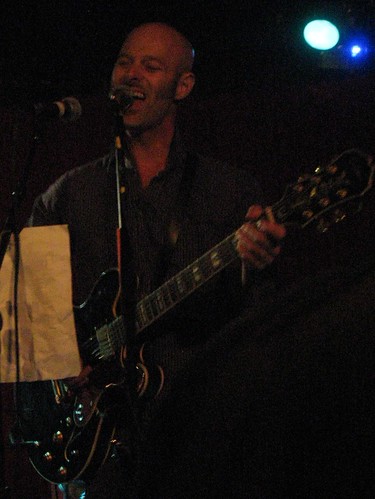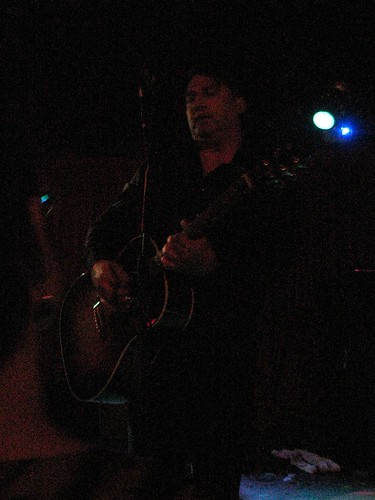Craig Wedren has long been a favorite of mine, both solo and in his game-changer band Shudder to Think, for always pushing his songwriting in new directions, and now he’s taking the same adventurous spirit into video. Wedren will be releasing a new album that will also have a companion interactive film, both titled Wand, in May. You can check out the 360-degree interactive video for the first single, “Are We”, at the link below.
Tag: Shudder to Think
Craig Wedren/Greg Dulli at the Grog Shop in Cleveland, OH, 10.16.10
Craig Wedren
Given my long-standing love for Greg Dulli (generally referred to in my world by his proper name: Greg fucking Dulli), it was a given that I would jump on tickets to this special acoustic show, Dulli’s first solo tour. When it was announced that Craig Wedren of Shudder to Think would be opening, my eyes nearly rolled back in my head. In the later 1990s, before bands began breaking up and band members died, my holy triumvirate of music was topped by the Afghan Whigs with Morphine and Shudder to Think anchoring the other corners. I was fortunate enough to see each of these bands play before tides turned, and I cherish the memory of those shows. To be able to check in with the frontmen of two of those bands in one night was a special treat.
Wedren looked exactly as I remembered seeing him back in 1997 when Shudder to Think toured in support of 50,000 B.C.: fresh, lean and handsome with a spectacular smile and a sparkle in his eye. Mixing his solo and film work (including a song from his project Baby) with a few Shudder to Think favorites – like the ubiquitous “Red House”, “Hit Liquor” and “X-French Tee Shirt” – Wedren switched off between acoustic and electric guitars and occasionally employed a loop station to create a rich layers of sound. And he was as at ease on stage as ever, cracking wise, musing and making dedications to his mother and his wife.
Craig Wedren’s best instrument has always been his voice, and it remains strong and supple. He ranges from baritone to falsetto and back again with ease, sometimes using the loop station to create eerie harmonies with himself. Beautiful from start to finish.
Greg Dulli
When Greg Dulli took the stage, flanked by frequent collaborator Dave Rosser on guitar and Rick Nelson on cello and violin, it seemed he might be satisfied to rest on his laurels for this low-key “Evening with”. While the first four songs of the set, which included the Gutter Twins’ “God’s Children” and brand new Twilight Singers’ track “Blackbird and the Fox”, were good, something was missing. The renowned Dulli fire was set to low. But with the Twilight Singers’ stormy “Bonnie Brae”, the burner was turned to high, and that familiar, scorching howl rolled forth from Dulli’s ragged throat.
Though the evening was heavy with Twilight Singers songs, Dulli did, as promised, trot out some Afghan Whigs classics like “Let Me Lie to You”, “If I Were Going” and “Summer’s Kiss”, and even, per an audience request, an unscheduled turn on “66” (the first time played on this tour, Dulli quipped that Cleveland had broken his cherry).
The encore, which kicked off with the Twilight Singers epic “Candy Cane Crawl”, contained the only true non-album cover of the night, a passionate take on José González’s “Down the Line”, culminating in Dulli’s repeated howl warning “Don’t let the darkness eat you up”. It was a goosebumps moment.
Dave Rosser already has a solid reputation as a stand-up guitarist and didn’t fail to impress, but it was Rick Nelson who really shined on the strings this night, sometimes flowing a layer of incomparable beauty under a song and sometimes ramping up the passion to roof-blowing proportions.
But it wasn’t a perfect evening. In attendance was the drunkest crowd I’ve ever experienced in such a small venue, and they kept sending their loudest, gabbiest emissaries to stand right in front of the stage and chit chat, both to Dulli and among themselves, through both sets of the night. One particular offender, who had bullied her way rudely in front of people who had been holding their spots for two hours, had to be called out by Dulli twice before she got the message to “shut your fucking mouth”. It was possibly the first time I’ve ever left a show annoyed.
Game Changer: Shudder to Think
It seems every music fanatic has at least one: a game changer. A band or album that slapped them upside the head, jarred them from complacency, shocked them into a different way of hearing or a different way of thinking. We’ve read the stories, about how, either through words that spoke to them in a way no one had spoken to them before or through an arrangement of sounds that were nothing like they had ever heard before, their internal worlds were forever changed.
My biggest game changer to date has been Shudder to Think. In 1994, I was heavily into Jeff Buckley and made a point of listening to the artists he covered and the artists he noted as favorites. Jeff had good, eclectic taste, and one of his well-documented favorites was Shudder to Think. S2T’s fifth studio album, Pony Express Record, was newly-released, and their video for “X-French Tee Shirt” was getting some play on MTV. It sounded weird to me. It was jagged and aggressive with frequent time changes and unconventional melodies. I had no idea what to make of it. I couldn’t even determine if I liked it or hated it. I wanted to hear it again.
Eventually, I bought Pony Express Record, and the whole album was a revelation. Everything that was contained in “X-French Tee Shirt” was on show, spread around and turned up. The album was pointy and electric and psychotic. It was, at turns, creepy, frightening, obscene, sexy, clever, ugly, beautiful. It was invigorating, and my mind opened up to what music could be in a way it hadn’t been since I first heard Ziggy Stardust and the Spiders from Mars. Pony Express Record cemented for me the idea that, while music could also go on just being fun and simple, it was important for music to move forward, open out, shake up, swallow whole and regurgitate as a new entity.
I went on to become a big fan of S2T in the short time they had left as a band at that point. I had the pleasure of seeing them live at Bimbo’s in San Francisco thirteen years ago this month. It was the day before or day after my birthday (my memory is fuzzy at best), and I got birthday hugs from Craig Wedren and Nathan Larson, who are two of the sweetest guys I’ve ever met. While the band has since dispersed to their own projects – with a reunion in 2008 – with varying degrees of success, S2T is still one of my favorite bands and Pony Express Record still serves as a mental measuring stick for me for all other music.
Shudder to Think MySpace
Craig Wedren Official Site
A Camp Official Site
Ponderous Wank: Connection
There is an alchemy that occurs when music is made. There is no formula, though. You cannot, for instance, take man + guitar + harmonica and get Bob Dylan every time. You cannot take sweeping samples + beats that feel like they grew up from the ground and into your soul + rhymes about Shaolin Kung Fu and get the Wu-Tang Clan every time. Even if you could come close to recreating that kind of magic in music, there is still the unpredictable variable of the listener. I love A.A. Bondy, but I don’t love every “folk” singer-songwriter with a guitar. I can barely come up with a handful of artists who could fit that category that I much care for. (And I have a hard time thinking of Bondy as a folk singer at all due to the loaded concept that term has come to engender over the years.)
The thing about music is that it is not a science. It’s human, living, changing thing. The musician brings her background, her emotions, her voice, skill, style, attitude, etc. The listener brings his experience, preferences, mood that day, memories, etc. Sometimes it all manages to fall into place and the listener finds several points where he connects to the artist’s music, whether it is through a sentiment in the lyrics, the way that E chord transitions into that Am chord or just the way the singer’s voice goes a little thin at the end of that verse. But many times, for whatever reason, there is a failure to connect.
This all makes me wonder why the major labels have had this habit of trying to milk (or even create) a genre when one act hits big or why album reviewers insist on
comparing X to Z. The A.A. Bondy: Bob Dylan comparison would be an obvious one for me to point out. If I had to choose someone to compare Bondy to, I’d more likely go for Neil Young, but I’ve never seen anyone else draw this comparison. And just now, I found a 1994 Rolling Stone review of the Afghan Whigs’ Gentlemen that compares Dulli and Co. to Pearl Jam. What?
I understand the human brain’s need to categorize things, but I think it serves an artist much better if she is judged on her own merit, without anyone else’s baggage to haul around with her. This is one of my favorite aspects of the internet revolution’s effect on music: the ability to judge an artist’s music on the artist’s music. Obviously, I enjoy writing about music, but it is first-hand experience that makes music such a lifeforce in the world. You won’t get pumped up or moved to tears by reading how Ian Felice of the Felice Brothers sounds just like Bob Dylan (is there anyone who artists are compared to more often than Dylan?). You can only experience music properly when you meet it head-on.
[youtube=http://www.youtube.com/watch?v=-BZQ6iuJ2kM]








